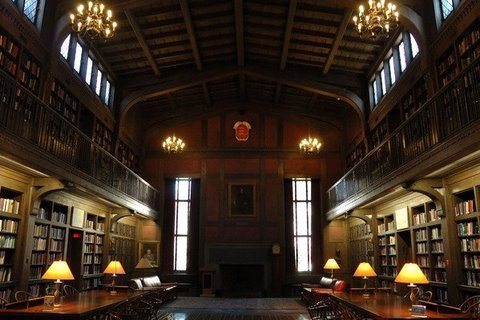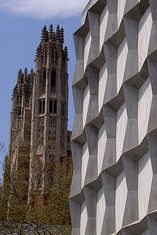Most of the architecture at Yale University is strikingly similar to the hallowed halls of ancient European universities such as Oxford or Cambridge. Much of its Gothic Revival or Georgian style buildings are simply awe-inspiring, providing an uplifting ambience for serious, scholarly study.
However, the architectural harmony on campus is shattered by the Beinecke Rare Book and Manuscript Library. Upon entering, one immediately perceives the absence of almost all natural light. The windowless main part of the library denies visitors that most basic natural element: sunlight. It gives the impression of being a lifeless mausoleum, a computerized warehouse for robots rather than an Ivy League library for humans.
Its giant honeycomb shaped walls of faintly-translucent granite placed within gray stone frames, together with the square waffle-pattern ceiling, make the library resemble the inside of a computer chip. The minimalist, square, metallic structure containing books offer the only clue that it is indeed a library. There are few chairs and no tables in sight. Where does one study here?
Just as the modern world tends to transform men into anonymous egalitarian “masses,” stripped of individual personality, so does this library seem to detach knowledge from the proper ambit of the human intellect. The building and the bookcases could just as easily be used to store computer servers, not precious tomes. It is, in effect, a display of relativistic egalitarian architecture, where each book is no greater or lesser than any other.
A library should reflect the wisdom and truth contained in its books. The Beinecke Library, however, reflects neither. The spirit of dehumanized egalitarianism in its architecture relegates the books to the level of mere “data” without beauty or wisdom. As a recent author put it, it is as “ugly as sin.”
Now let us turn to another library at Yale.

Where Noble Thoughts Soar
This is the Medical Historical Library at Yale University. Look at its robust ship-like timbers, high open ceilings, and brass chandeliers. They form an ideal setting for calm reflection or serious study, where the most noble aspirations of the mind soar freely.

at Yale University.
Notice the pleasant interplay of light and shadow that seem to pay homage to the distinguished intellects whose works are displayed here. The predominant woodwork creates a warm yet dignified atmosphere for study. Every minute detail, the fireplace, oil paintings, coat of arms, thick beams, leaded windows, tables and lamps please the eye and speak of tradition, unpretentious erudition and manly distinction. One could easily picture Sir Winston Churchill seated at one of those polished wood tables preparing his next parliamentary speech.
Would the harmony of this beautiful library survive if flashy computers were installed? Would a college student hooked on our cyber pop-culture, wearing ripped jeans, flip-flops and body piercing feel comfortable in this dignified atmosphere? Probably not.
Yet libraries like these formed Churchills, not hippies. Yes, this library, unlike the cold, box-like architecture of the Beinecke Library, allows students to embark on new intellectual and spiritual discoveries. This library, steeped in tradition, fosters true progress — progress within the marvelous framework of order created by God.
What noble tradition.

